Capitol Records STEREO Original Released
#02 The Beatles' Second Album (ST-2080)
(Update: 15th May 2025)


 Capitol 1st. Sleeve |
|
|
|
TITLE
|
THE BEATLES' SECOND ALBUM |
||||||||||||||||||||||||||||||||||
| CATALOG
NUMBER |
ST-2080 |
||||||||||||||||||||||||||||||||||
|
RELEASE DATE
|
10th April.1964/First Press | ||||||||||||||||||||||||||||||||||
| TITLE LISTING |
SIDE
1 |
SIDE
2 |
|||||||||||||||||||||||||||||||||
| Roll Over
Beethoven (BMI-2:44) |
Long Tall Sally (BMI) |
||||||||||||||||||||||||||||||||||
| Thank You Girl (BMI-2:01) | I Call Your Name
(ASCAP) |
||||||||||||||||||||||||||||||||||
| You Really Got A Hold On Me (BMI-2:58) | Please Mister Postman (BMI-2:34) | ||||||||||||||||||||||||||||||||||
| Devil In Her Heart (BMI-2:23) | I'll Get You
(ASCAP-2:04) (simulated stereo) |
||||||||||||||||||||||||||||||||||
| Money (That's What I Want) (BMI-2:47) | She Loves You
(ASCAP-2:19) (simulated stereo) |
||||||||||||||||||||||||||||||||||
| You Can't Do That
(ASCAP-2:33) |
|||||||||||||||||||||||||||||||||||
| FRONT--> Click! | BACK --> Click! | SIDE 1 --> Click! | SIDE 2 --> Click! | DISK --> Click! | |||||||||||||||||||||||||||||||
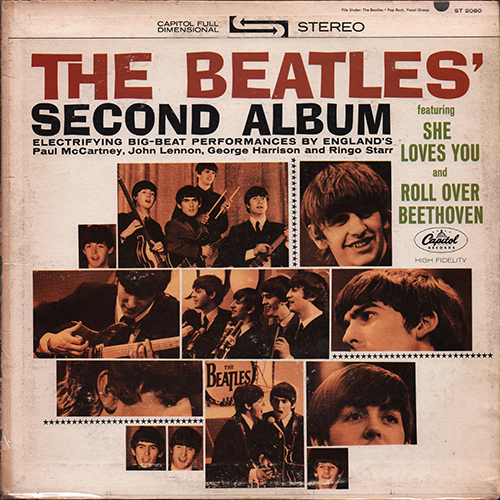 |
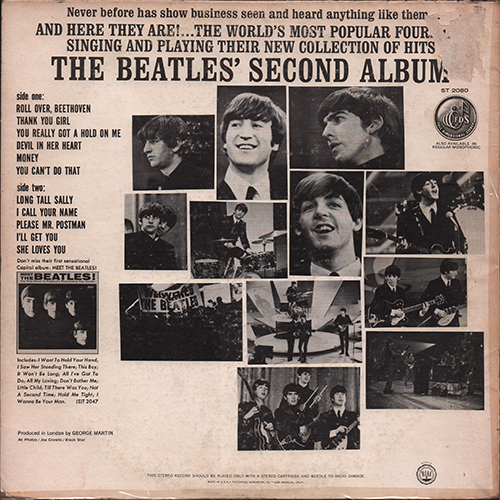 |
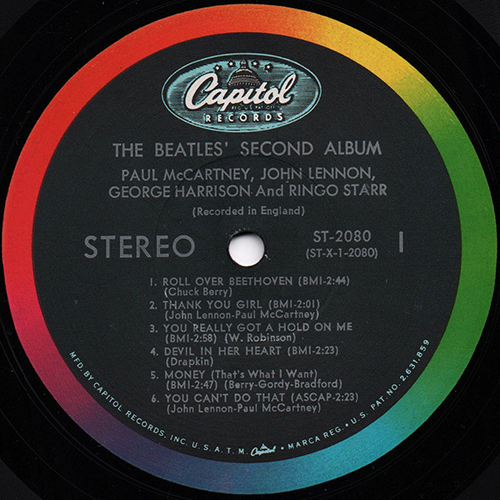 |
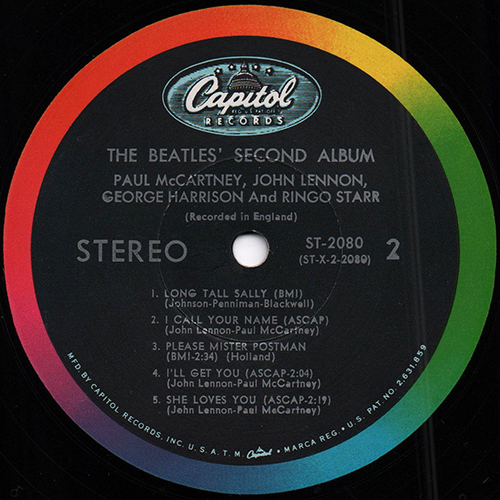 |
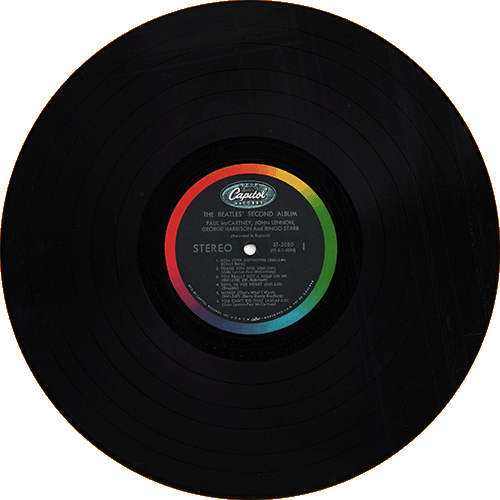 |
|||||||||||||||||||||||||||||||
| INNER SLEEVE | FRONT COVER CLOSE UP | ||||||||||||||||||||||||||||||||||
| FRONT--> Click! | BACK --> Click! | ||||||||||||||||||||||||||||||||||
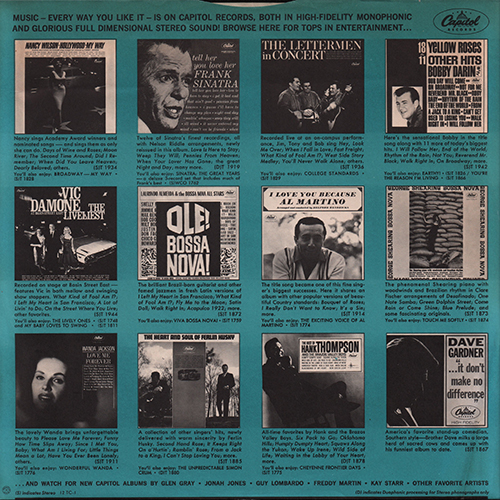 |
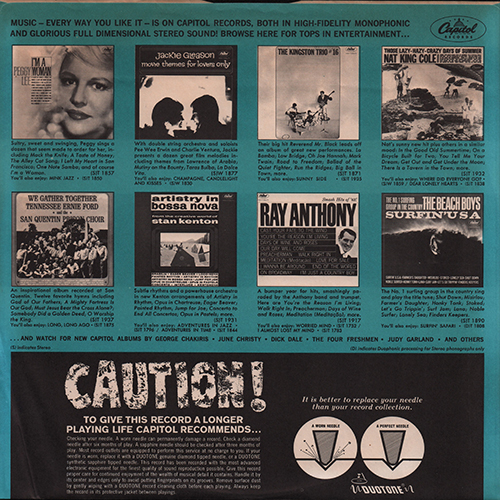 |
 |
|||||||||||||||||||||||||||||||||
| The exposed portion of the back liner
that wrapped around to the top of the jacket has the phrase
"File Under: The Beatles • Pop Rock, Vocal Group" as well as
a large black dot and the catalogue number. |
|||||||||||||||||||||||||||||||||||
| FRONT COVER CLOSE UP | |||||||||||||||||||||||||||||||||||
 |
 |
The front cover slicks is cut and positioned to reveal the Capitol Full Demensional Stereo arrow logo at the top. | |||||||||||||||||||||||||||||||||
| BACK COVER CLOSE UP | |||||||||||||||||||||||||||||||||||
 |
 |
 |
|||||||||||||||||||||||||||||||||
| Back liner has the catalogue number "ST 2080", the "Full Dimensional Stereo" circle logo and "Also Available In Regular Monophonic" in the upper right corner. | |||||||||||||||||||||||||||||||||||
| BACK COVER CLOSE UP | |||||||||||||||||||||||||||||||||||
 |
|||||||||||||||||||||||||||||||||||
| The lower portion of the back
liner contains "MADE IN U.S.A. • FACTORIES: SCRANTON, PA. -
LOS ANGELES, CALIF." and the RIAA (Record Industry
Association of America" logo. Most of the back liners have a small numeral located near the lower right or left corner. These numbers were used by Capitol to identify where the album cover was manufactured. (3=Scranton) |
|||||||||||||||||||||||||||||||||||
| LABEL CLOSE UP | |||||||||||||||||||||||||||||||||||
 |
 |
||||||||||||||||||||||||||||||||||
| The original
issue Capitol albums were manufactured with black label
backdrops with an outer rim colorband. The labels for records manufactured on the East Coast were printed by Keystone Printed Specialties, Inc. in Scranton, Pennsylvania. |
The text of the perimeter print in blue on the original issue discs states "MFD. BY CAPITOL RECORDS. INC. U.S.A. T.M." to the left of a small Capitol logo, with "• MARCA REG. • U.S. PAT. NO. 2, 631,859" to the right. On some labels, the perimeter print is in white. | ||||||||||||||||||||||||||||||||||
 |
 |
The labels can be differentiated by the
font of the number "one" at nine ofclock on the side one
labels. |
|||||||||||||||||||||||||||||||||
| LABEL CLOSE UP | |||||||||||||||||||||||||||||||||||
| SIDE 1 --> Click! | SIDE 2 --> Click! | ||||||||||||||||||||||||||||||||||
 |
 |
 |
|||||||||||||||||||||||||||||||||
| Because the label copy for the
record was prepared prior to Capitol receiving the master
tapes for the two newly recorded songs, Long Tall Sally and
I Call Your Name, the labels to the first pressings do not
list the times for these songs. In fact, except for a few
scarce variations, later pressings are also missing the
times for these songs even though the information was
available. The initial stereo labels are also missing running times for Long Tall Sally and I Call Your Name and list ASCAP as the performing rights organization for I Call Your Name. |
|||||||||||||||||||||||||||||||||||
 |
Most of the labels for the
album show the running time for You Canft Do That as 2:33.
Some of the first East Coast labels have a typo listing the
time for the song as 2:23. (East Coast only) |
||||||||||||||||||||||||||||||||||
|
OTHER ITEM
|
|||||||||||||||||||||||||||||||||||
| - | |||||||||||||||||||||||||||||||||||
| LABEL | Capitol
Black
label
with
color band Type-1 |
||||||||||||||||||||||||||||||||||
| MIX | STEREO |
||||||||||||||||||||||||||||||||||
| VINYL COLOR | Black |
||||||||||||||||||||||||||||||||||
| PRESS FACTORY |
SLEEVE | East
Coast: Queens Litho in New York |
|||||||||||||||||||||||||||||||||
| VINYL | Scranton,
Pennsylvania / LABEL: Keystone Printed Specialties, Inc. in
Scranton, Pensylvania. |
||||||||||||||||||||||||||||||||||
| FACTORY CODE | 3 | ||||||||||||||||||||||||||||||||||
| MATRIX No. | SIDE 1 |
ST-1-2080
- A3 #2 IAM mark
& (machine stamped) |
|||||||||||||||||||||||||||||||||
| SIDE 2 |
ST-2-2080 - B2 #2 IAM mark & (machine stamped) | ||||||||||||||||||||||||||||||||||
| PUBLISHER'S NAME |
- |
||||||||||||||||||||||||||||||||||
|
"SUBSIDIARY" PRINT
|
- |
||||||||||||||||||||||||||||||||||
| COVER FORM |
Single
type.
Housed
in
a cardboard jacket. |
||||||||||||||||||||||||||||||||||
| INNER SLEEVE | Capitol
Company
Sleeve Type-2: Light blue sleeve |
||||||||||||||||||||||||||||||||||
| COVER DESIGN/ PHOTO/ NOTES | Front
Cover
Design:
George
Osaki All Photos: Joe Covello / Black Star |
||||||||||||||||||||||||||||||||||
| PRODUCER | Produced
in
London
by
George Martin |
||||||||||||||||||||||||||||||||||
|
COMMENTS
|
The Beatles' Second Album is the
Beatles' second Capitol Records album, and their third album
released in the United States including Introducing... The
Beatles released three months earlier on Vee-Jay Records.
The Beatles' Second Album replaced Meet the Beatles! at
number one on the album charts in the US. The white front cover to "The Beatles' Second Album" , which was also designed by George Osaki, features a layout of sepia-tinted photographs of the band. There are two group shots: one posing in front of a curtain at The Ed Sullivan Show and one from the Kennedy airport press conference. All photos were taken by Joe Covello and licensed through Black Star. The initial slicks have the group's name in a brownish red and the song titles in dark green. Later slicks have "THE BEATLES" in bright red and the song titles in olive green. The black and white back liner also features photographs of the band. Four of the pictures feature Ed Sullivan Show performances. Three is also a performance shot from the Washington Coliseum concert. The minor color variation among covers is due to the front slicks being prepared by differeint printers. Front slicks were printed on: 1-1) East Coast: Queens Litho in New York 1-2) East Coast: Ivy Hill Lithograph Co. in New York 2) West Coast: Bert-Co Enterprise of Los Angeles. When "The Beatles' Second Album" was originally issued, Capitol had factories in 1) Scranton, Pensylvania 2) Los Angeles, California 3) In mid. 1965, added a pressing plant in Jacksonville, Illinois. (Stereo Only) The lower portion of the back liner contains "MADE IN U.S.A. • FACTORIES: SCRANTON, PA. - LOS ANGELES, CALIF." and the RIAA (Record Industry Association of America" logo. Most of the back liners have a small numeral located near the lower right or left corner. These numbers were used by Capitol to identify where the album cover was manufactured. Capitol did not fabricate its own album covers. Capitol required the cover manufacturer to place a factory identification number on the back liners. The fabricators added a small number, usually in the lower right corner. The following tables detail the cover numbers that are known to exist: Compiled by Frank Daniels in 2012 The Beatles' Second Album (S)T-2080
The original issue Capitol albums were manufactured with black label backdrops with an outer rim colorband. Label copy information specific to each album appears in silver print. The labels for records manufactured on: 1) The East Coast were printed by Keystone Printed Specialties, Inc. in Scranton, Pensylvania. 2) The West Coast were printed by Bert-Co Enterprises in Los Angeles, California. There are East Coast and West Coast label variations. 1-1) The initial stereo labels are also missing running times for Long Tall Sally and I Call Your Name and list ASCAP as the performing rights organization for I Call Your Name. (East Coast and West Coast) 1-2) Most of the labels for the album show the running time for You Canft Do That as 2:33. Some of the first East Coast labels have a typo listing the time for the song as 2:23. (East Coast only) 2-1) The printer for the East Coast stereo label changed BMI to ASCAP after "You Can't Do That" on side-1(?) 2-2) Subsequent stereo labels are inconsistent. After Capitol obtained the master tapes for Long Tall Sally and I Call Your Name, it added the running times for the songs. There are East Coast labels with running times for Long Tall Sally and I Call Your Name. (East Coast only) 3-1) When BMI replaced ASCAP for I Call Your Name, Capitol once again revised its label copy. The printer for the East Coast stereo label not only changed ASCAP to BMI after I Call Your Name, but also dropped the running time for the song. Thus, this variation has the time for Long Tall Sally, but not I Call Your Name. (East Coast only) 3-2) Some of these labels have a typo, with the latter track mistakenly shown as I Call You Name. (East Coast only) 4) Later pressings of the album list BMI for I Call Your Name and do not have running times for either Long Tall Sally or I Call Your Name. Unlike the West Coast first pressing, the stereo version of this final variation has centered label copy and gSTEREOh spaced loosely. (West Coast only) 5) There is also an in-house Jacksonville stereo version with small print used for the album title and band member names. There are two typesetting variations of the Jacksonville labels. 5-1) Earlier labels have all information set close to the center hole whereas. 5-2) later labels have a large gap between the information above and below the center hole. |
||||||||||||||||||||||||||||||||||
|
TITLE
|
THE BEATLES' SECOND ALBUM |
||||||||||||||||||||||||||||||||||
| CATALOG
NUMBER |
ST-2080 |
||||||||||||||||||||||||||||||||||
|
RELEASE DATE
|
10th April.1964/First Press | ||||||||||||||||||||||||||||||||||
| TITLE LISTING |
SIDE
1 |
SIDE
2 |
|||||||||||||||||||||||||||||||||
| Roll Over
Beethoven (BMI-2:44) |
Long Tall Sally (BMI) |
||||||||||||||||||||||||||||||||||
| Thank You Girl (BMI-2:01) | I Call Your Name
(ASCAP) |
||||||||||||||||||||||||||||||||||
| You Really Got A Hold On Me (BMI-2:58) | Please Mister Postman (BMI-2:34) | ||||||||||||||||||||||||||||||||||
| Devil In Her Heart (BMI-2:23) | I'll Get You
(ASCAP-2:04) (simulated stereo) |
||||||||||||||||||||||||||||||||||
| Money (That's What I Want) (BMI-2:47) | She Loves You
(ASCAP-2:19) (simulated stereo) |
||||||||||||||||||||||||||||||||||
| You Can't Do That
(ASCAP-2:33) |
|||||||||||||||||||||||||||||||||||
| FRONT--> Click! | BACK --> Click! | SIDE 1 --> Click! | SIDE 2 --> Click! | DISK --> Click! | |||||||||||||||||||||||||||||||
 |
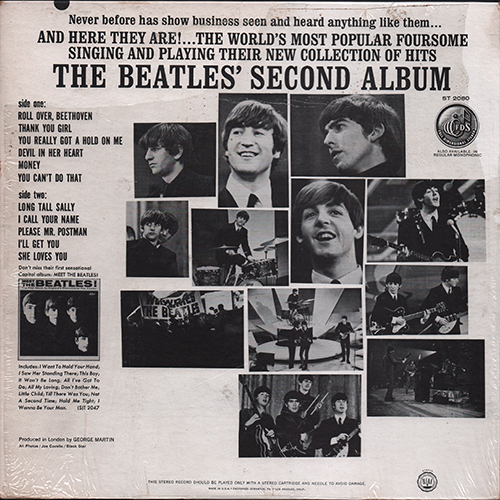 |
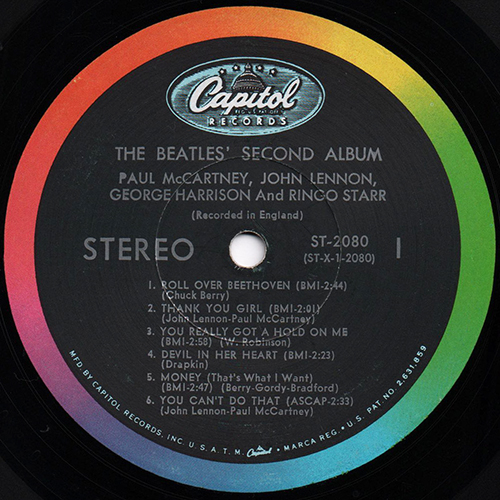 |
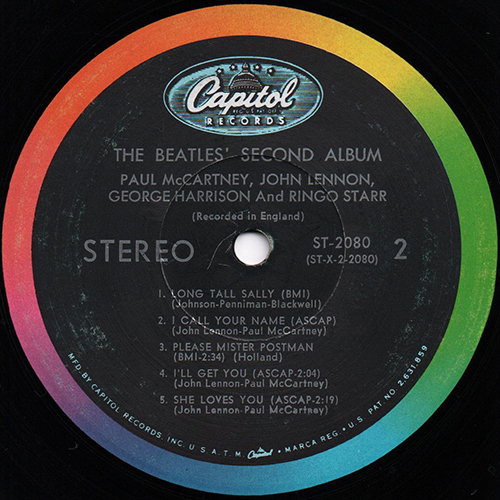 |
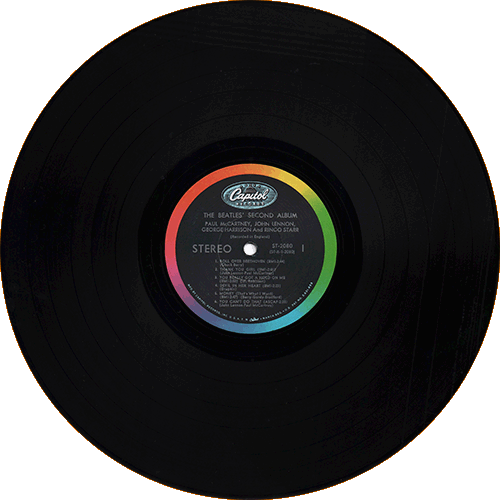 |
|||||||||||||||||||||||||||||||
| INNER SLEEVE | FRONT COVER CLOSE UP | ||||||||||||||||||||||||||||||||||
| FRONT--> Click! | BACK --> Click! | ||||||||||||||||||||||||||||||||||
 |
 |
 |
|||||||||||||||||||||||||||||||||
| The exposed portion of the back liner
that wrapped around to the top of the jacket has the phrase
"File Under: The Beatles • Pop Rock, Vocal Group" as well as
a large black dot and the catalogue number. |
|||||||||||||||||||||||||||||||||||
| FRONT COVER CLOSE UP | |||||||||||||||||||||||||||||||||||
 |
On
stereo jackets, the front cover slicks is cut and positioned
to reveal the Capitol Full Demensional Stereo arrow logo at
the top. |
||||||||||||||||||||||||||||||||||
| FRONT COVER CLOSE UP | BACK COVER CLOSE UP | ||||||||||||||||||||||||||||||||||
 |
The Capitol logo and the phrase "HIGH FIDELITY" appear in black at the right side of the front cover. |  |
 |
||||||||||||||||||||||||||||||||
| Back liner has the catalogue number "ST 2080", the "Full Dimensional Stereo" circle logo and "Also Available In Regular Monophonic" in the upper right corner. | |||||||||||||||||||||||||||||||||||
| BACK COVER CLOSE UP | |||||||||||||||||||||||||||||||||||
 |
 |
||||||||||||||||||||||||||||||||||
| The lower portion of the back
liner contains "MADE IN U.S.A. • FACTORIES: SCRANTON, PA. -
LOS ANGELES, CALIF." and the RIAA (Record Industry
Association of America" logo. Most of the back liners have a small numeral located near the lower right or left corner. These numbers were used by Capitol to identify where the album cover was manufactured. (Back liners were sometimes printed without any identification number.) |
|||||||||||||||||||||||||||||||||||
| LABEL CLOSE UP | |||||||||||||||||||||||||||||||||||
 |
 |
||||||||||||||||||||||||||||||||||
| The original
issue Capitol albums were manufactured with black label
backdrops with an outer rim colorband. The labels for records manufactured on the East Coast were printed by Keystone Printed Specialties, Inc. in Scranton, Pennsylvania. |
The text of the perimeter print in blue on the original issue discs states "MFD. BY CAPITOL RECORDS. INC. U.S.A. T.M." to the left of a small Capitol logo, with "• MARCA REG. • U.S. PAT. NO. 2, 631,859" to the right. On some labels, the perimeter print is in white. | ||||||||||||||||||||||||||||||||||
 |
 |
The labels can be differentiated by the
font of the number "one" at nine ofclock on the side one
labels. |
|||||||||||||||||||||||||||||||||
| LABEL CLOSE UP | |||||||||||||||||||||||||||||||||||
| SIDE 1 --> Click! | SIDE 2 --> Click! | ||||||||||||||||||||||||||||||||||
 |
 |
 |
|||||||||||||||||||||||||||||||||
| Because the label copy for the
record was prepared prior to Capitol receiving the master
tapes for the two newly recorded songs, Long Tall Sally and
I Call Your Name, the labels to the first pressings do not
list the times for these songs. In fact, except for a few
scarce variations, later pressings are also missing the
times for these songs even though the information was
available. The initial stereo labels are also missing running times for Long Tall Sally and I Call Your Name and list ASCAP as the performing rights organization for I Call Your Name. |
|||||||||||||||||||||||||||||||||||
 |
Most of the labels for the
album show the running time for You Canft Do That as 2:33.
Some of the first East Coast labels have a typo listing the
time for the song as 2:23. (East Coast only) |
||||||||||||||||||||||||||||||||||
|
OTHER ITEM
|
|||||||||||||||||||||||||||||||||||
| - | |||||||||||||||||||||||||||||||||||
| LABEL | Capitol
Black
label
with
color
band Type-1 |
||||||||||||||||||||||||||||||||||
| MIX | STEREO |
||||||||||||||||||||||||||||||||||
| VINYL COLOR | Black |
||||||||||||||||||||||||||||||||||
| PRESS FACTORY |
SLEEVE | East
Coast: Queens Litho in New York |
|||||||||||||||||||||||||||||||||
| VINYL | Scranton,
Pennsylvania
/ LABEL: Keystone Printed Specialties, Inc. in Scranton,
Pensylvania. |
||||||||||||||||||||||||||||||||||
| FACTORY CODE | None | ||||||||||||||||||||||||||||||||||
| MATRIX No. | SIDE 1 |
ST-1-2080
-
B4 IAM mark
& (machine stamped) |
|||||||||||||||||||||||||||||||||
| SIDE 2 |
ST-2-2080 - B2 #3 IAM mark & (machine stamped) | ||||||||||||||||||||||||||||||||||
| PUBLISHER'S NAME |
- |
||||||||||||||||||||||||||||||||||
|
"SUBSIDIARY" PRINT
|
- |
||||||||||||||||||||||||||||||||||
| COVER FORM |
Single
type.
Housed
in
a
cardboard jacket. |
||||||||||||||||||||||||||||||||||
| INNER SLEEVE | Capitol
Company
Sleeve
Type-2: Light blue sleeve |
||||||||||||||||||||||||||||||||||
| COVER DESIGN/ PHOTO/ NOTES | Front
Cover Design: George Osaki All Photos: Joe Covello / Black Star |
||||||||||||||||||||||||||||||||||
| PRODUCER | Produced
in
London
by
George
Martin |
||||||||||||||||||||||||||||||||||
|
COMMENTS
|
The Beatles' Second Album is the
Beatles' second Capitol Records album, and their third album
released in the United States including Introducing... The
Beatles released three months earlier on Vee-Jay Records.
The Beatles' Second Album replaced Meet the Beatles! at
number one on the album charts in the US. The white front cover to "The Beatles' Second Album" , which was also designed by George Osaki, features a layout of sepia-tinted photographs of the band. There are two group shots: one posing in front of a curtain at The Ed Sullivan Show and one from the Kennedy airport press conference. All photos were taken by Joe Covello and licensed through Black Star. The initial slicks have the group's name in a brownish red and the song titles in dark green. Later slicks have "THE BEATLES" in bright red and the song titles in olive green. The black and white back liner also features photographs of the band. Four of the pictures feature Ed Sullivan Show performances. Three is also a performance shot from the Washington Coliseum concert. The minor color variation among covers is due to the front slicks being prepared by differeint printers. Front slicks were printed on: 1-1) East Coast: Queens Litho in New York 1-2) East Coast: Ivy Hill Lithograph Co. in New York 2) West Coast: Bert-Co Enterprise of Los Angeles. When "The Beatles' Second Album" was originally issued, Capitol had factories in 1) Scranton, Pensylvania 2) Los Angeles, California 3) In mid. 1965, added a pressing plant in Jacksonville, Illinois. (Stereo Only) The lower portion of the back liner contains "MADE IN U.S.A. • FACTORIES: SCRANTON, PA. - LOS ANGELES, CALIF." and the RIAA (Record Industry Association of America" logo. Most of the back liners have a small numeral located near the lower right or left corner. These numbers were used by Capitol to identify where the album cover was manufactured. Capitol did not fabricate its own album covers. Capitol required the cover manufacturer to place a factory identification number on the back liners. The fabricators added a small number, usually in the lower right corner. The following tables detail the cover numbers that are known to exist: Compiled by Frank Daniels in 2012 The Beatles' Second Album (S)T-2080
The original issue Capitol albums were manufactured with black label backdrops with an outer rim colorband. Label copy information specific to each album appears in silver print. The labels for records manufactured on: 1) The East Coast were printed by Keystone Printed Specialties, Inc. in Scranton, Pensylvania. 2) The West Coast were printed by Bert-Co Enterprises in Los Angeles, California. There are East Coast and West Coast label variations. 1-1) The initial stereo labels are also missing running times for Long Tall Sally and I Call Your Name and list ASCAP as the performing rights organization for I Call Your Name. (East Coast and West Coast) 1-2) Most of the labels for the album show the running time for You Canft Do That as 2:33. Some of the first East Coast labels have a typo listing the time for the song as 2:23. (East Coast only) 2-1) The printer for the East Coast stereo label changed BMI to ASCAP after "You Can't Do That" on side-1(?) 2-2) Subsequent stereo labels are inconsistent. After Capitol obtained the master tapes for Long Tall Sally and I Call Your Name, it added the running times for the songs. There are East Coast labels with running times for Long Tall Sally and I Call Your Name. (East Coast only) 3-1) When BMI replaced ASCAP for I Call Your Name, Capitol once again revised its label copy. The printer for the East Coast stereo label not only changed ASCAP to BMI after I Call Your Name, but also dropped the running time for the song. Thus, this variation has the time for Long Tall Sally, but not I Call Your Name. (East Coast only) 3-2) Some of these labels have a typo, with the latter track mistakenly shown as I Call You Name. (East Coast only) 4) Later pressings of the album list BMI for I Call Your Name and do not have running times for either Long Tall Sally or I Call Your Name. Unlike the West Coast first pressing, the stereo version of this final variation has centered label copy and gSTEREOh spaced loosely. (West Coast only) 5) There is also an in-house Jacksonville stereo version with small print used for the album title and band member names. There are two typesetting variations of the Jacksonville labels. 5-1) Earlier labels have all information set close to the center hole whereas. 5-2) later labels have a large gap between the information above and below the center hole. |
||||||||||||||||||||||||||||||||||
|
TITLE
|
THE BEATLES' SECOND ALBUM |
||||||||||||||||||||||||||||||||||
| CATALOG
NUMBER |
ST-2080 |
||||||||||||||||||||||||||||||||||
|
RELEASE DATE
|
10th April.1964/First Press | ||||||||||||||||||||||||||||||||||
| TITLE LISTING |
SIDE
1 |
SIDE
2 |
|||||||||||||||||||||||||||||||||
| Roll Over
Beethoven (BMI-2:44) |
Long Tall Sally (BMI) |
||||||||||||||||||||||||||||||||||
| Thank You Girl (BMI-2:01) | I Call Your Name
(ASCAP) |
||||||||||||||||||||||||||||||||||
| You Really Got A Hold On Me (BMI-2:58) | Please Mister Postman (BMI-2:34) | ||||||||||||||||||||||||||||||||||
| Devil In Her Heart (BMI-2:23) | I'll Get You
(ASCAP-2:04) (simulated stereo) |
||||||||||||||||||||||||||||||||||
| Money (That's What I Want) (BMI-2:47) | She Loves You
(ASCAP-2:19) (simulated stereo) |
||||||||||||||||||||||||||||||||||
| You Can't Do That
(ASCAP-2:33) |
|||||||||||||||||||||||||||||||||||
| FRONT--> Click! | BACK --> Click! | SIDE 1 --> Click! | SIDE 2 --> Click! | DISK | |||||||||||||||||||||||||||||||
 |
 |
 |
 |
 |
|||||||||||||||||||||||||||||||
| INNER SLEEVE | FRONT COVER CLOSE UP | ||||||||||||||||||||||||||||||||||
| FRONT--> Click! | BACK --> Click! | ||||||||||||||||||||||||||||||||||
 |
 |
 |
|||||||||||||||||||||||||||||||||
| The exposed portion of the back liner
that wrapped around to the top of the jacket has the phrase
"File Under: The Beatles • Pop Rock, Vocal Group" as well as
a large black dot and the catalogue number. |
|||||||||||||||||||||||||||||||||||
| FRONT COVER CLOSE UP | |||||||||||||||||||||||||||||||||||
 |
On
stereo jackets, the front cover slicks is cut and positioned
to reveal the Capitol Full Demensional Stereo arrow logo at
the top. |
||||||||||||||||||||||||||||||||||
| FRONT COVER CLOSE UP | BACK COVER CLOSE UP | ||||||||||||||||||||||||||||||||||
 |
The Capitol logo and the phrase "HIGH FIDELITY" appear in black at the right side of the front cover. |  |
 |
||||||||||||||||||||||||||||||||
| Back liner has the catalogue number "ST 2080", the "Full Dimensional Stereo" circle logo and "Also Available In Regular Monophonic" in the upper right corner. | |||||||||||||||||||||||||||||||||||
| BACK COVER CLOSE UP | |||||||||||||||||||||||||||||||||||
 |
 |
 |
|||||||||||||||||||||||||||||||||
| The lower portion of the back
liner contains "MADE IN U.S.A. • FACTORIES: SCRANTON, PA. -
LOS ANGELES, CALIF." and the RIAA (Record Industry
Association of America" logo. Most of the back liners have a small numeral located near the lower right or left corner. These numbers were used by Capitol to identify where the album cover was manufactured. (5=Los Angeles factory) |
|||||||||||||||||||||||||||||||||||
| LABEL CLOSE UP | |||||||||||||||||||||||||||||||||||
 |
 |
 |
 |
||||||||||||||||||||||||||||||||
| The original issue Capitol albums were manufactured with black label backdrops with an outer rim colorband. | The labels for the West Coast were printed by Bert-Co Enterprises in Los Angeles, California. The labels can be differentiated by the font of the number "one" at nine ofclock on the side one labels. | ||||||||||||||||||||||||||||||||||
| LABEL CLOSE UP | |||||||||||||||||||||||||||||||||||
| SIDE 1 --> Click! | SIDE 2 --> Click! | ||||||||||||||||||||||||||||||||||
 |
 |
 |
|||||||||||||||||||||||||||||||||
| Because the label copy for the
record was prepared prior to Capitol receiving the master
tapes for the two newly recorded songs, Long Tall Sally and
I Call Your Name, the labels to the first pressings do not
list the times for these songs. In fact, except for a few
scarce variations, later pressings are also missing the
times for these songs even though the information was
available. The initial stereo labels are also missing running times for Long Tall Sally and I Call Your Name and list ASCAP as the performing rights organization for I Call Your Name. |
|||||||||||||||||||||||||||||||||||
| LABEL CLOSE UP | |||||||||||||||||||||||||||||||||||
 |
The text of the perimeter print in blue on the original issue discs states "MFD. BY CAPITOL RECORDS. INC. U.S.A. T.M." to the left of a small Capitol logo, with "• MARCA REG. • U.S. PAT. NO. 2, 631,859" to the right. On some labels, the perimeter print is in white. | ||||||||||||||||||||||||||||||||||
|
OTHER ITEM
|
|||||||||||||||||||||||||||||||||||
| - | |||||||||||||||||||||||||||||||||||
| LABEL | Capitol
Black
label
with
color
band Type-1 |
||||||||||||||||||||||||||||||||||
| MIX | STEREO |
||||||||||||||||||||||||||||||||||
| VINYL COLOR | Black |
||||||||||||||||||||||||||||||||||
| PRESS FACTORY |
SLEEVE | West
Coast: Bert-Co Enterprise of Los Angeles |
|||||||||||||||||||||||||||||||||
| VINYL | Los
Angeles, California |
||||||||||||||||||||||||||||||||||
| FACTORY CODE | 5 |
||||||||||||||||||||||||||||||||||
| MATRIX No. | SIDE 1 |
ST-1-2080-A-5'
(hand
etched)
* (machine
stamped) |
|||||||||||||||||||||||||||||||||
| SIDE 2 |
ST-2-2080-A-5' (hand etched) 3 * (machine stamped) | ||||||||||||||||||||||||||||||||||
| PUBLISHER'S NAME |
- |
||||||||||||||||||||||||||||||||||
|
"SUBSIDIARY" PRINT
|
- |
||||||||||||||||||||||||||||||||||
| COVER FORM |
Single
type.
Housed
in
a
cardboard jacket. |
||||||||||||||||||||||||||||||||||
| INNER SLEEVE | Capitol
Company
Sleeve
Type-2: Light blue sleeve |
||||||||||||||||||||||||||||||||||
| COVER DESIGN/ PHOTO/ NOTES | Front
Cover Design: George Osaki All Photos: Joe Covello / Black Star |
||||||||||||||||||||||||||||||||||
| PRODUCER | Produced
in
London
by
George
Martin |
||||||||||||||||||||||||||||||||||
|
COMMENTS
|
The Beatles' Second Album is the
Beatles' second Capitol Records album, and their third album
released in the United States including Introducing... The
Beatles released three months earlier on Vee-Jay Records.
The Beatles' Second Album replaced Meet the Beatles! at
number one on the album charts in the US. The white front cover to "The Beatles' Second Album" , which was also designed by George Osaki, features a layout of sepia-tinted photographs of the band. There are two group shots: one posing in front of a curtain at The Ed Sullivan Show and one from the Kennedy airport press conference. All photos were taken by Joe Covello and licensed through Black Star. The initial slicks have the group's name in a brownish red and the song titles in dark green. Later slicks have "THE BEATLES" in bright red and the song titles in olive green. The black and white back liner also features photographs of the band. Four of the pictures feature Ed Sullivan Show performances. Three is also a performance shot from the Washington Coliseum concert. The minor color variation among covers is due to the front slicks being prepared by differeint printers. Front slicks were printed on: 1-1) East Coast: Queens Litho in New York 1-2) East Coast: Ivy Hill Lithograph Co. in New York 2) West Coast: Bert-Co Enterprise of Los Angeles. When "The Beatles' Second Album" was originally issued, Capitol had factories in 1) Scranton, Pensylvania 2) Los Angeles, California 3) In mid. 1965, added a pressing plant in Jacksonville, Illinois. (Stereo Only) The lower portion of the back liner contains "MADE IN U.S.A. • FACTORIES: SCRANTON, PA. - LOS ANGELES, CALIF." and the RIAA (Record Industry Association of America" logo. Most of the back liners have a small numeral located near the lower right or left corner. These numbers were used by Capitol to identify where the album cover was manufactured. Capitol did not fabricate its own album covers. Capitol required the cover manufacturer to place a factory identification number on the back liners. The fabricators added a small number, usually in the lower right corner. The following tables detail the cover numbers that are known to exist: Compiled by Frank Daniels in 2012 The Beatles' Second Album (S)T-2080
The original issue Capitol albums were manufactured with black label backdrops with an outer rim colorband. Label copy information specific to each album appears in silver print. The labels for records manufactured on: 1) The East Coast were printed by Keystone Printed Specialties, Inc. in Scranton, Pensylvania. 2) The West Coast were printed by Bert-Co Enterprises in Los Angeles, California. There are East Coast and West Coast label variations. 1-1) The initial stereo labels are also missing running times for Long Tall Sally and I Call Your Name and list ASCAP as the performing rights organization for I Call Your Name. (East Coast and West Coast) 1-2) Most of the labels for the album show the running time for You Canft Do That as 2:33. Some of the first East Coast labels have a typo listing the time for the song as 2:23. (East Coast only) 2-1) The printer for the East Coast stereo label changed BMI to ASCAP after "You Can't Do That" on side-1(?) 2-2) Subsequent stereo labels are inconsistent. After Capitol obtained the master tapes for Long Tall Sally and I Call Your Name, it added the running times for the songs. There are East Coast labels with running times for Long Tall Sally and I Call Your Name. (East Coast only) 3-1) When BMI replaced ASCAP for I Call Your Name, Capitol once again revised its label copy. The printer for the East Coast stereo label not only changed ASCAP to BMI after I Call Your Name, but also dropped the running time for the song. Thus, this variation has the time for Long Tall Sally, but not I Call Your Name. (East Coast only) 3-2) Some of these labels have a typo, with the latter track mistakenly shown as I Call You Name. (East Coast only) 4) Later pressings of the album list BMI for I Call Your Name and do not have running times for either Long Tall Sally or I Call Your Name. Unlike the West Coast first pressing, the stereo version of this final variation has centered label copy and gSTEREOh spaced loosely. (West Coast only) 5) There is also an in-house Jacksonville stereo version with small print used for the album title and band member names. There are two typesetting variations of the Jacksonville labels. 5-1) Earlier labels have all information set close to the center hole whereas. 5-2) later labels have a large gap between the information above and below the center hole. |
||||||||||||||||||||||||||||||||||
|
TITLE
|
THE BEATLES' SECOND ALBUM |
||||||||||||||||||||||||||||||||||
| CATALOG
NUMBER |
ST-2080 |
||||||||||||||||||||||||||||||||||
|
RELEASE DATE
|
late 1964? /Third Press | ||||||||||||||||||||||||||||||||||
| TITLE LISTING |
SIDE
1 |
SIDE
2 |
|||||||||||||||||||||||||||||||||
| Roll Over
Beethoven (BMI-2:44) |
Long Tall Sally (BMI) |
||||||||||||||||||||||||||||||||||
| Thank You Girl (BMI-2:01) | I Call Your Name
(ASCAP) |
||||||||||||||||||||||||||||||||||
| You Really Got A Hold On Me (BMI-2:58) | Please Mister Postman (BMI-2:34) | ||||||||||||||||||||||||||||||||||
| Devil In Her Heart (BMI-2:23) | I'll Get You
(ASCAP-2:04) (simulated stereo) |
||||||||||||||||||||||||||||||||||
| Money (That's What I Want) (BMI-2:47) | She Loves You
(ASCAP-2:19) (simulated stereo) |
||||||||||||||||||||||||||||||||||
| You Can't Do That
(BMI-2:33) |
|||||||||||||||||||||||||||||||||||
| FRONT--> Click! | BACK --> Click! | SIDE 1 --> Click! | SIDE 2 --> Click! | DISK --> Click! | |||||||||||||||||||||||||||||||
 |
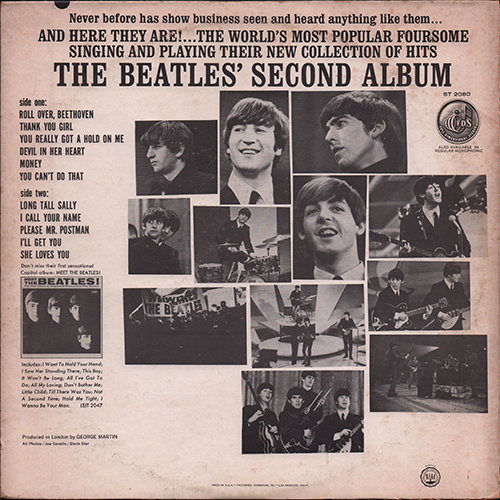 |
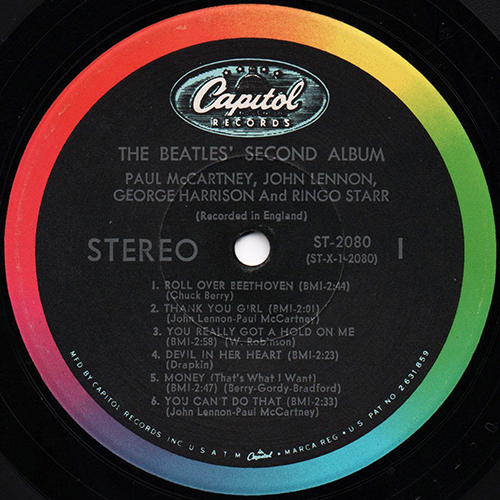 |
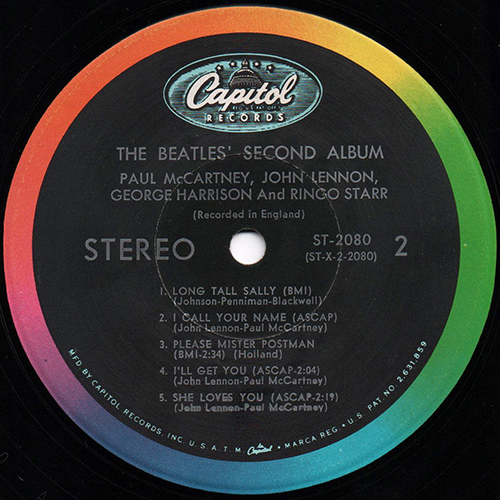 |
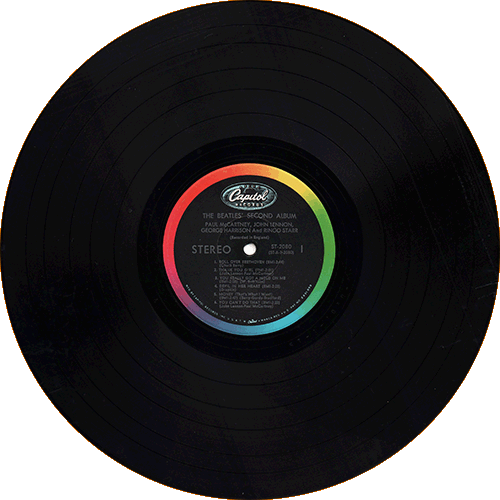 |
|||||||||||||||||||||||||||||||
| INNER SLEEVE | FRONT COVER CLOSE UP | ||||||||||||||||||||||||||||||||||
| FRONT--> Click! | BACK --> Click! | ||||||||||||||||||||||||||||||||||
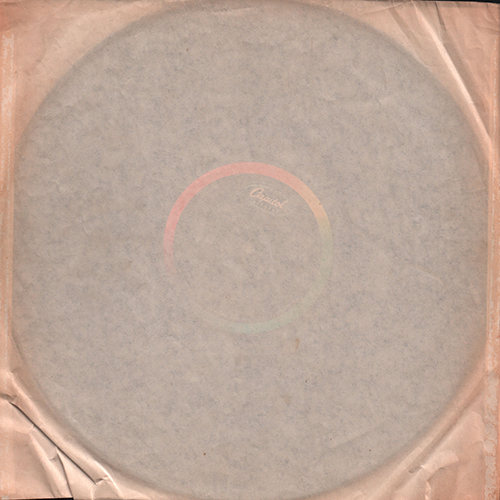 |
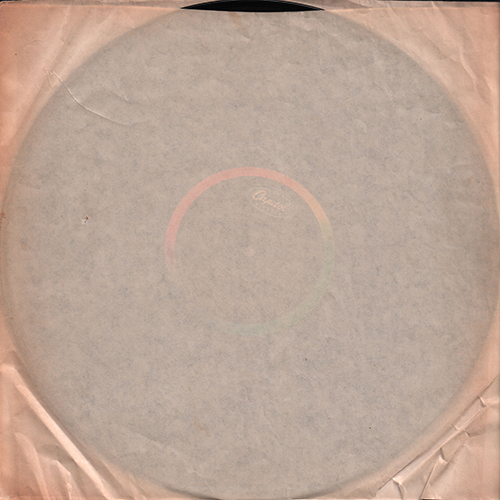 |
 |
|||||||||||||||||||||||||||||||||
| The exposed portion of the back liner
that wrapped around to the top of the jacket has the phrase
"File Under: The Beatles • Pop Rock, Vocal Group" as well as
a large black dot and the catalogue number. |
|||||||||||||||||||||||||||||||||||
| FRONT COVER CLOSE UP | |||||||||||||||||||||||||||||||||||
 |
On
stereo jackets, the front cover slicks is cut and positioned
to reveal the Capitol Full Demensional Stereo arrow logo at
the top. |
||||||||||||||||||||||||||||||||||
| FRONT COVER CLOSE UP | BACK COVER CLOSE UP | ||||||||||||||||||||||||||||||||||
 |
The Capitol logo and the phrase "HIGH FIDELITY" appear in black at the right side of the front cover. |  |
 |
||||||||||||||||||||||||||||||||
| Back liner has the catalogue number "ST 2080", the "Full Dimensional Stereo" circle logo and "Also Available In Regular Monophonic" in the upper right corner. | |||||||||||||||||||||||||||||||||||
| BACK COVER CLOSE UP | |||||||||||||||||||||||||||||||||||
 |
 |
||||||||||||||||||||||||||||||||||
| The lower portion of the back
liner contains "MADE IN U.S.A. • FACTORIES: SCRANTON, PA. -
LOS ANGELES, CALIF." and the RIAA (Record Industry
Association of America" logo. But, "This stereo record should be played ....damage" credit was removed. Most of the back liners have a small numeral located near the lower right or left corner. These numbers were used by Capitol to identify where the album cover was manufactured. (3=Scranton factory) |
|||||||||||||||||||||||||||||||||||
| LABEL CLOSE UP | |||||||||||||||||||||||||||||||||||
 |
 |
||||||||||||||||||||||||||||||||||
| The original
issue Capitol albums were manufactured with black label
backdrops with an outer rim colorband. The labels for records manufactured on the East Coast were printed by Keystone Printed Specialties, Inc. in Scranton, Pennsylvania. |
The text of the perimeter print in blue on the original issue discs states "MFD. BY CAPITOL RECORDS. INC. U.S.A. T.M." to the left of a small Capitol logo, with "• MARCA REG. • U.S. PAT. NO. 2, 631,859" to the right. On some labels, the perimeter print is in white. | ||||||||||||||||||||||||||||||||||
 |
 |
The labels can be differentiated by the
font of the number "one" at nine ofclock on the side one
labels. |
|||||||||||||||||||||||||||||||||
| LABEL CLOSE UP | |||||||||||||||||||||||||||||||||||
| SIDE 1 --> Click! | SIDE 2 --> Click! | ||||||||||||||||||||||||||||||||||
 |
 |
 |
|||||||||||||||||||||||||||||||||
 |
The printer for the East Coast stereo label changed BMI to ASCAP after "You Can't Do That" on side-1(?) | ||||||||||||||||||||||||||||||||||
| For "Beatles' Second Album",
there are basic label variations that can be distinguished
by the performing rights organization (BMI or ASCAP) that
appears in parentheses after each song title. The initial stereo labels on side-2 are also missing running times for "Long Tall Sally" and "I Call Your Name" and list ASCAP as the performing rights organization for "I Call Your Name". The printer for the East Coast stereo label changed BMI to ASCAP after "You Can't Do That" on side-1. |
|||||||||||||||||||||||||||||||||||
|
OTHER ITEM
|
|||||||||||||||||||||||||||||||||||
| - | |||||||||||||||||||||||||||||||||||
| LABEL | Capitol
Black
label
with
color
band Type-1 |
||||||||||||||||||||||||||||||||||
| MIX | STEREO |
||||||||||||||||||||||||||||||||||
| VINYL COLOR | Black |
||||||||||||||||||||||||||||||||||
| PRESS FACTORY |
SLEEVE | East
Coast: Queens Litho in New York |
|||||||||||||||||||||||||||||||||
| VINYL | Scranton,
Pennsylvania
/ LABEL: Keystone Printed Specialties, Inc. in Scranton,
Pensylvania. |
||||||||||||||||||||||||||||||||||
| FACTORY CODE | None | ||||||||||||||||||||||||||||||||||
| MATRIX No. | SIDE 1 |
ST-1-2080-
B2
IAM mark
& (machine stamped) |
|||||||||||||||||||||||||||||||||
| SIDE 2 |
ST-2-2080- A1 #2 IAM mark & (machine stamped) | ||||||||||||||||||||||||||||||||||
| PUBLISHER'S NAME |
- |
||||||||||||||||||||||||||||||||||
|
"SUBSIDIARY" PRINT
|
- |
||||||||||||||||||||||||||||||||||
| COVER FORM |
Single
type.
Housed
in
a
cardboard jacket. |
||||||||||||||||||||||||||||||||||
| INNER SLEEVE | Capitol
Company
Sleeve
Type-2: Light blue sleeve |
||||||||||||||||||||||||||||||||||
| COVER DESIGN/ PHOTO/ NOTES | Front
Cover Design: George Osaki All Photos: Joe Covello / Black Star |
||||||||||||||||||||||||||||||||||
| PRODUCER | Produced
in
London
by
George
Martin |
||||||||||||||||||||||||||||||||||
|
COMMENTS
|
The Beatles' Second Album is the
Beatles' second Capitol Records album, and their third album
released in the United States including Introducing... The
Beatles released three months earlier on Vee-Jay Records.
The Beatles' Second Album replaced Meet the Beatles! at
number one on the album charts in the US. The white front cover to "The Beatles' Second Album" , which was also designed by George Osaki, features a layout of sepia-tinted photographs of the band. There are two group shots: one posing in front of a curtain at The Ed Sullivan Show and one from the Kennedy airport press conference. All photos were taken by Joe Covello and licensed through Black Star. The initial slicks have the group's name in a brownish red and the song titles in dark green. Later slicks have "THE BEATLES" in bright red and the song titles in olive green. The black and white back liner also features photographs of the band. Four of the pictures feature Ed Sullivan Show performances. Three is also a performance shot from the Washington Coliseum concert. The minor color variation among covers is due to the front slicks being prepared by differeint printers. Front slicks were printed on: 1-1) East Coast: Queens Litho in New York 1-2) East Coast: Ivy Hill Lithograph Co. in New York 2) West Coast: Bert-Co Enterprise of Los Angeles. When "The Beatles' Second Album" was originally issued, Capitol had factories in 1) Scranton, Pensylvania 2) Los Angeles, California 3) In mid. 1965, added a pressing plant in Jacksonville, Illinois. (Stereo Only) The lower portion of the back liner contains "MADE IN U.S.A. • FACTORIES: SCRANTON, PA. - LOS ANGELES, CALIF." and the RIAA (Record Industry Association of America" logo. Most of the back liners have a small numeral located near the lower right or left corner. These numbers were used by Capitol to identify where the album cover was manufactured. Capitol did not fabricate its own album covers. Capitol required the cover manufacturer to place a factory identification number on the back liners. The fabricators added a small number, usually in the lower right corner. The following tables detail the cover numbers that are known to exist: Compiled by Frank Daniels in 2012 The Beatles' Second Album (S)T-2080
The original issue Capitol albums were manufactured with black label backdrops with an outer rim colorband. Label copy information specific to each album appears in silver print. The labels for records manufactured on: 1) The East Coast were printed by Keystone Printed Specialties, Inc. in Scranton, Pensylvania. 2) The West Coast were printed by Bert-Co Enterprises in Los Angeles, California. There are East Coast and West Coast label variations. 1-1) The initial stereo labels are also missing running times for Long Tall Sally and I Call Your Name and list ASCAP as the performing rights organization for I Call Your Name. (East Coast and West Coast) 1-2) Most of the labels for the album show the running time for You Canft Do That as 2:33. Some of the first East Coast labels have a typo listing the time for the song as 2:23. (East Coast only) 2-1) The printer for the East Coast stereo label changed BMI to ASCAP after "You Can't Do That" on side-1(?) 2-2) Subsequent stereo labels are inconsistent. After Capitol obtained the master tapes for Long Tall Sally and I Call Your Name, it added the running times for the songs. There are East Coast labels with running times for Long Tall Sally and I Call Your Name. (East Coast only) 3-1) When BMI replaced ASCAP for I Call Your Name, Capitol once again revised its label copy. The printer for the East Coast stereo label not only changed ASCAP to BMI after I Call Your Name, but also dropped the running time for the song. Thus, this variation has the time for Long Tall Sally, but not I Call Your Name. (East Coast only) 3-2) Some of these labels have a typo, with the latter track mistakenly shown as I Call You Name. (East Coast only) 4) Later pressings of the album list BMI for I Call Your Name and do not have running times for either Long Tall Sally or I Call Your Name. Unlike the West Coast first pressing, the stereo version of this final variation has centered label copy and gSTEREOh spaced loosely. (West Coast only) 5) There is also an in-house Jacksonville stereo version with small print used for the album title and band member names. There are two typesetting variations of the Jacksonville labels. 5-1) Earlier labels have all information set close to the center hole whereas. 5-2) later labels have a large gap between the information above and below the center hole. |
||||||||||||||||||||||||||||||||||
|
TITLE
|
THE BEATLES' SECOND ALBUM |
||||||||||||||||||||||||||||||||||
| CATALOG
NUMBER |
ST-2080 |
||||||||||||||||||||||||||||||||||
|
RELEASE DATE
|
1966? / 6th. Press? | ||||||||||||||||||||||||||||||||||
| TITLE LISTING |
SIDE
1 |
SIDE
2 |
|||||||||||||||||||||||||||||||||
| Roll Over
Beethoven (BMI-2:44) |
Long Tall Sally (BMI) |
||||||||||||||||||||||||||||||||||
| Thank You Girl (BMI-2:01) | I Call Your Name
(BMI) |
||||||||||||||||||||||||||||||||||
| You Really Got A Hold On Me (BMI-2:58) | Please Mister Postman (BMI-2:34) | ||||||||||||||||||||||||||||||||||
| Devil In Her Heart (BMI-2:23) | I'll Get You (BMI-2:04) (simulated stereo) |
||||||||||||||||||||||||||||||||||
| Money (That's What I Want) (BMI-2:47) | She Loves You
(ASCAP-2:19) (simulated stereo) |
||||||||||||||||||||||||||||||||||
| You Can't Do That
(BMI-2:33) |
|||||||||||||||||||||||||||||||||||
| FRONT--> Click! | BACK --> Click! | SIDE 1 --> Click! | SIDE 2 --> Click! | DISK | |||||||||||||||||||||||||||||||
 |
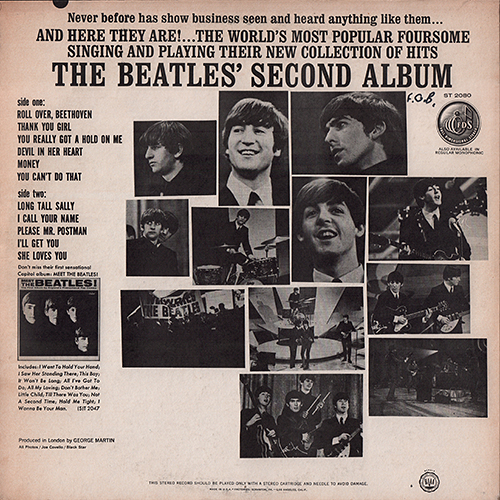 |
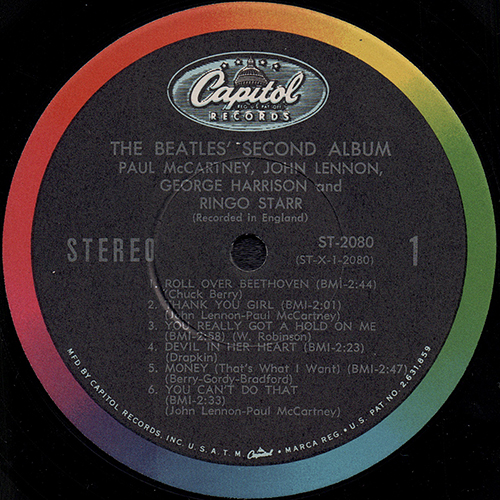 |
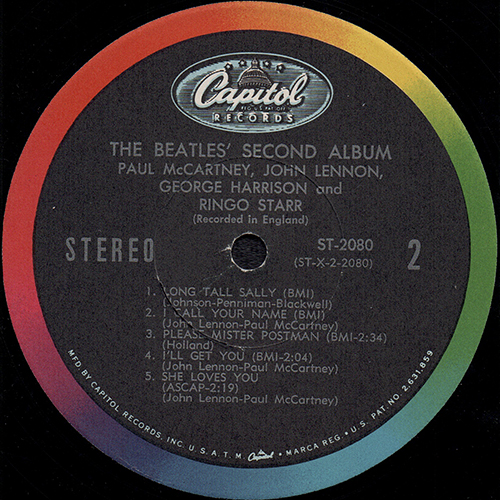 |
 |
|||||||||||||||||||||||||||||||
| INNER SLEEVE | FRONT COVER CLOSE UP | ||||||||||||||||||||||||||||||||||
| FRONT--> Click! | BACK --> Click! | ||||||||||||||||||||||||||||||||||
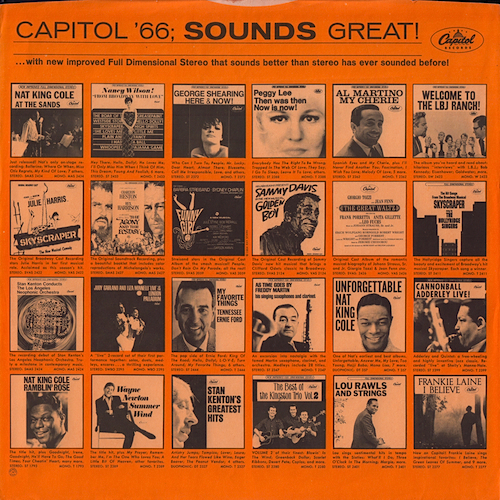 |
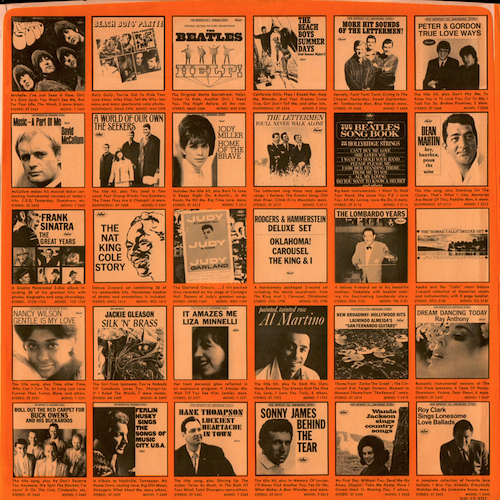 |
 |
|||||||||||||||||||||||||||||||||
| The exposed portion of the back liner
that wrapped around to the top of the jacket has the phrase
"File Under: The Beatles • Pop Rock, Vocal Group" as well as
a large black dot and the catalogue number. |
|||||||||||||||||||||||||||||||||||
| FRONT COVER CLOSE UP | |||||||||||||||||||||||||||||||||||
 |
On
stereo jackets, the front cover slicks is cut and positioned
to reveal the Capitol Full Demensional Stereo arrow logo at
the top. |
||||||||||||||||||||||||||||||||||
| FRONT COVER CLOSE UP | BACK COVER CLOSE UP | ||||||||||||||||||||||||||||||||||
 |
The Capitol logo and the phrase "HIGH FIDELITY" appear in black at the right side of the front cover. |  |
 |
||||||||||||||||||||||||||||||||
| Back liner has the catalogue number "ST 2080", the "Full Dimensional Stereo" circle logo and "Also Available In Regular Monophonic" in the upper right corner. | |||||||||||||||||||||||||||||||||||
| BACK COVER CLOSE UP | |||||||||||||||||||||||||||||||||||
 |
 |
||||||||||||||||||||||||||||||||||
| The
lower portion of the back liner contains "MADE IN U.S.A. •
FACTORIES: SCRANTON, PA. - LOS ANGELES, CALIF." and the RIAA
(Record Industry Association of America" logo. Most of the back liners have a small numeral located near the lower right or left corner. These numbers were used by Capitol to identify where the album cover was manufactured. (6=Los Angeles factory) |
|||||||||||||||||||||||||||||||||||
| LABEL CLOSE UP | |||||||||||||||||||||||||||||||||||
 |
The original issue Capitol albums
were manufactured with black label backdrops with an outer
rim colorband. |
 |
|||||||||||||||||||||||||||||||||
| Catalogue number
"ST-2080" was printed at the right side of the center hole. |
|||||||||||||||||||||||||||||||||||
| LABEL CLOSE UP | |||||||||||||||||||||||||||||||||||
| SIDE 1 --> Click! |
SIDE 2 --> Click! |
There
are
4 basic label variations that can be distinguished by the
performing rights organization (BMI or ASCAP) that appears
in parentheses after each song title. 4) Later pressings of the album list BMI for "I Call Your Name" and do not have times for either "Long Tall Sally" or "I Call Your Name" |
|||||||||||||||||||||||||||||||||
 |
 |
||||||||||||||||||||||||||||||||||
| LABEL CLOSE UP | |||||||||||||||||||||||||||||||||||
 |
The text of the perimeter print in blue on the original issue discs states "MFD. BY CAPITOL RECORDS. INC. U.S.A. T.M." to the left of a small Capitol logo, with "• MARCA REG. • U.S. PAT. NO. 2, 631,859" to the right. On some labels, the perimeter print is in white. | ||||||||||||||||||||||||||||||||||
|
OTHER ITEM
|
|||||||||||||||||||||||||||||||||||
| - | |||||||||||||||||||||||||||||||||||
| LABEL | Capitol
Black
label with color band Type-1 |
||||||||||||||||||||||||||||||||||
| MIX | STEREO |
||||||||||||||||||||||||||||||||||
| VINYL COLOR | Black |
||||||||||||||||||||||||||||||||||
| PRESS FACTORY |
SLEEVE | West
Coast: Bert-Co Enterprise of Los Angeles |
|||||||||||||||||||||||||||||||||
| VINYL | Los
Angeles, California |
||||||||||||||||||||||||||||||||||
| FACTORY CODE | None |
||||||||||||||||||||||||||||||||||
| MATRIX No. | SIDE 1 |
ST-1-2080-B-6'
(hand
etched) 2 *
(machine stamped) |
|||||||||||||||||||||||||||||||||
| SIDE 2 |
ST-2-2080-B-6' (hand etched) 1 * (machine stamped) | ||||||||||||||||||||||||||||||||||
| PUBLISHER'S NAME |
- |
||||||||||||||||||||||||||||||||||
|
"SUBSIDIARY" PRINT
|
- |
||||||||||||||||||||||||||||||||||
| COVER FORM |
Single
type.
Housed in a cardboard jacket. |
||||||||||||||||||||||||||||||||||
| INNER SLEEVE | Capitol
Company
Sleeve Type-6: Orange sleeve (Sound Great!) |
||||||||||||||||||||||||||||||||||
| COVER DESIGN/ PHOTO/ NOTES | Front
Cover
Design: George Osaki All Photos: Joe Covello / Black Star |
||||||||||||||||||||||||||||||||||
| PRODUCER | Produced
in
London by George Martin |
||||||||||||||||||||||||||||||||||
|
COMMENTS
|
The Beatles' Second Album is the
Beatles' second Capitol Records album, and their third album
released in the United States including Introducing... The
Beatles released three months earlier on Vee-Jay Records.
The Beatles' Second Album replaced Meet the Beatles! at
number one on the album charts in the US. The white front cover to "The Beatles' Second Album" , which was also designed by George Osaki, features a layout of sepia-tinted photographs of the band. There are two group shots: one posing in front of a curtain at The Ed Sullivan Show and one from the Kennedy airport press conference. All photos were taken by Joe Covello and licensed through Black Star. The initial slicks have the group's name in a brownish red and the song titles in dark green. Later slicks have "THE BEATLES" in bright red and the song titles in olive green. The black and white back liner also features photographs of the band. Four of the pictures feature Ed Sullivan Show performances. Three is also a performance shot from the Washington Coliseum concert. The minor color variation among covers is due to the front slicks being prepared by differeint printers. Front slicks were printed on: 1-1) East Coast: Queens Litho in New York 1-2) East Coast: Ivy Hill Lithograph Co. in New York 2) West Coast: Bert-Co Enterprise of Los Angeles. When "The Beatles' Second Album" was originally issued, Capitol had factories in 1) Scranton, Pensylvania 2) Los Angeles, California 3) In mid. 1965, added a pressing plant in Jacksonville, Illinois. (Stereo Only) The lower portion of the back liner contains "MADE IN U.S.A. • FACTORIES: SCRANTON, PA. - LOS ANGELES, CALIF." and the RIAA (Record Industry Association of America" logo. Most of the back liners have a small numeral located near the lower right or left corner. These numbers were used by Capitol to identify where the album cover was manufactured. Capitol did not fabricate its own album covers. Capitol required the cover manufacturer to place a factory identification number on the back liners. The fabricators added a small number, usually in the lower right corner. The following tables detail the cover numbers that are known to exist: Compiled by Frank Daniels in 2012 The Beatles' Second Album (S)T-2080
The original issue Capitol albums were manufactured with black label backdrops with an outer rim colorband. Label copy information specific to each album appears in silver print. The labels for records manufactured on: 1) The East Coast were printed by Keystone Printed Specialties, Inc. in Scranton, Pensylvania. 2) The West Coast were printed by Bert-Co Enterprises in Los Angeles, California. There are East Coast and West Coast label variations. 1-1) The initial stereo labels are also missing running times for Long Tall Sally and I Call Your Name and list ASCAP as the performing rights organization for I Call Your Name. (East Coast and West Coast) 1-2) Most of the labels for the album show the running time for You Canft Do That as 2:33. Some of the first East Coast labels have a typo listing the time for the song as 2:23. (East Coast only) 2-1) The printer for the East Coast stereo label changed BMI to ASCAP after "You Can't Do That" on side-1(?) 2-2) Subsequent stereo labels are inconsistent. After Capitol obtained the master tapes for Long Tall Sally and I Call Your Name, it added the running times for the songs. There are East Coast labels with running times for Long Tall Sally and I Call Your Name. (East Coast only) 3-1) When BMI replaced ASCAP for I Call Your Name, Capitol once again revised its label copy. The printer for the East Coast stereo label not only changed ASCAP to BMI after I Call Your Name, but also dropped the running time for the song. Thus, this variation has the time for Long Tall Sally, but not I Call Your Name. (East Coast only) 3-2) Some of these labels have a typo, with the latter track mistakenly shown as I Call You Name. (East Coast only) 4) Later pressings of the album list BMI for I Call Your Name and do not have running times for either Long Tall Sally or I Call Your Name. Unlike the West Coast first pressing, the stereo version of this final variation has centered label copy and gSTEREOh spaced loosely. (West Coast only) 5) There is also an in-house Jacksonville stereo version with small print used for the album title and band member names. There are two typesetting variations of the Jacksonville labels. 5-1) Earlier labels have all information set close to the center hole whereas. 5-2) later labels have a large gap between the information above and below the center hole. |
||||||||||||||||||||||||||||||||||
|
TITLE
|
THE BEATLES' SECOND ALBUM |
||||||||||||||||||||||||||||||||||
| CATALOG
NUMBER |
ST-2080 |
||||||||||||||||||||||||||||||||||
|
RELEASE DATE
|
late 1969? / 8th Press? | ||||||||||||||||||||||||||||||||||
| TITLE LISTING |
SIDE
1 |
SIDE
2 |
|||||||||||||||||||||||||||||||||
| Roll Over
Beethoven (BMI-2:44) |
Long Tall Sally
(BMI) |
||||||||||||||||||||||||||||||||||
| Thank You Girl (BMI-2:01) | I Call Your Name
(BMI) |
||||||||||||||||||||||||||||||||||
| You Really Got A Hold On Me (BMI-2:58) | Please Mister Postman (BMI-2:34) | ||||||||||||||||||||||||||||||||||
| Devil In Her Heart (BMI-2:23) | I'll Get You
(BMI-2:04) (simulated stereo) |
||||||||||||||||||||||||||||||||||
| Money (That's What I Want) (BMI-2:47) | She Loves You
(BMI-2:19) (simulated stereo) |
||||||||||||||||||||||||||||||||||
| You Can't Do That
(BMI-2:33) |
|||||||||||||||||||||||||||||||||||
| FRONT--> Click! | BACK --> Click! | SIDE 1 --> Click! | SIDE 2 --> Click! | DISK --> Click! | |||||||||||||||||||||||||||||||
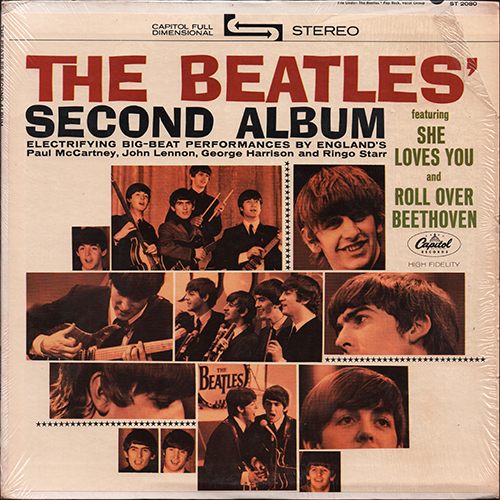 |
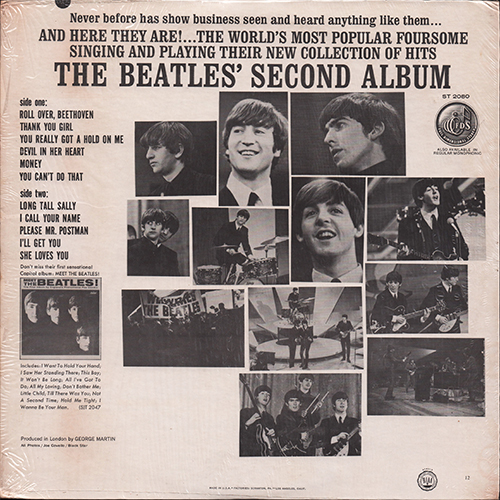 |
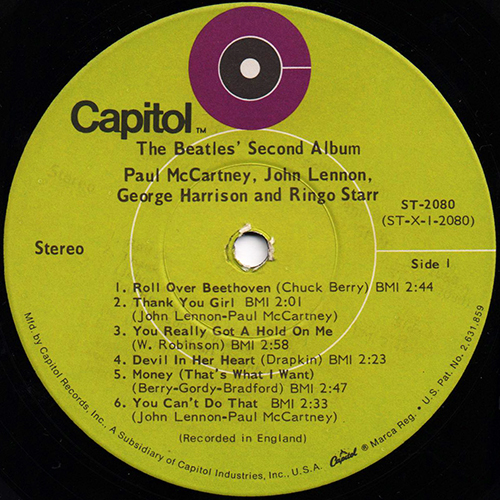 |
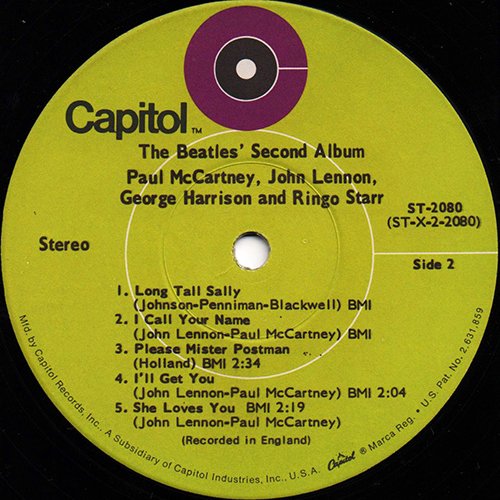 |
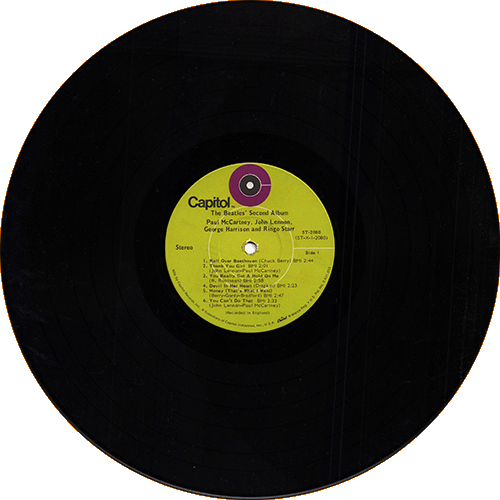 |
|||||||||||||||||||||||||||||||
| INNER SLEEVE | FRONT COVER CLOSE UP | ||||||||||||||||||||||||||||||||||
| FRONT--> Click! | BACK --> Click! | ||||||||||||||||||||||||||||||||||
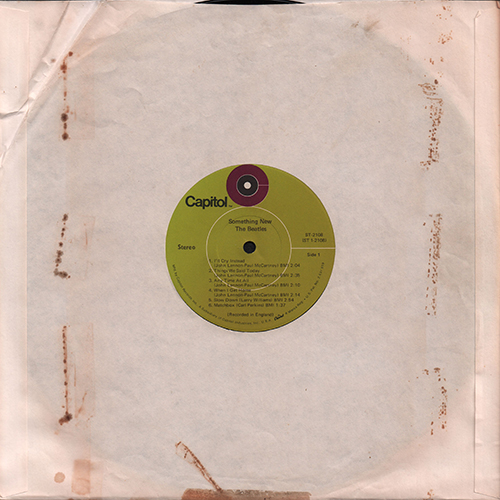 |
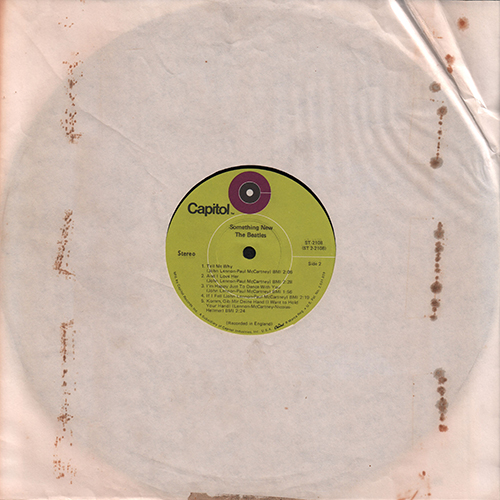 |
 |
|||||||||||||||||||||||||||||||||
| The exposed portion of the back liner
that wrapped around to the top of the jacket has the phrase
"File Under: The Beatles • Pop Rock, Vocal Group" as well as
a large black dot and the catalogue number. |
|||||||||||||||||||||||||||||||||||
| FRONT COVER CLOSE UP | |||||||||||||||||||||||||||||||||||
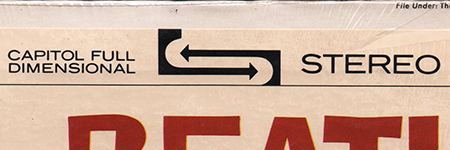 |
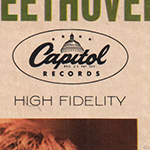 |
On stereo jackets, the front cover slicks is cut and positioned to reveal the Capitol Full Demensional Stereo arrow logo at the top. | |||||||||||||||||||||||||||||||||
| FRONT COVER CLOSE UP | BACK COVER CLOSE UP | ||||||||||||||||||||||||||||||||||
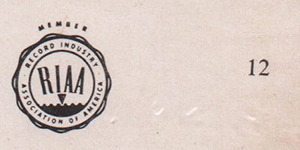 |
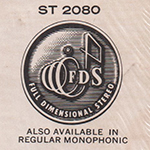 |
 |
|||||||||||||||||||||||||||||||||
| Back liner has the catalogue number "ST 2080", the "Full Dimensional Stereo" circle logo and "Also Available In Regular Monophonic" in the upper right corner. | |||||||||||||||||||||||||||||||||||
| The lower portion of the back liner contains "MADE IN U.S.A. • FACTORIES: SCRANTON, PA. - LOS ANGELES, CALIF." and the RIAA (Record Industry Association of America" logo. Most of the back liners have a small numeral located near the lower right or left corner. These numbers were used by Capitol to identify where the album cover was manufactured. (12=Winchester factory) | |||||||||||||||||||||||||||||||||||
 |
|||||||||||||||||||||||||||||||||||
| LABEL CLOSE UP | |||||||||||||||||||||||||||||||||||
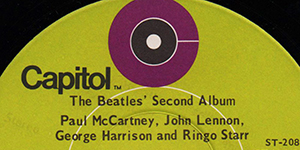 |
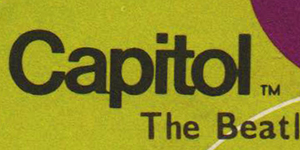 |
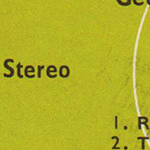 |
|||||||||||||||||||||||||||||||||
| In July 1969,
Capitol switched to a limecolored label featuring its new
circle logo at the top. The outer "C" is purple and the
circle representing the record is black. |
The initial
lime labels have a TM designation following the word
Capitol. After the trade mark for the logo was secured, the
TM marking was switched to the (R) symbol, which appears
below the "I" in Capitol. |
||||||||||||||||||||||||||||||||||
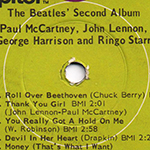 |
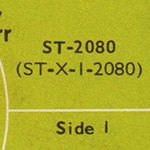 |
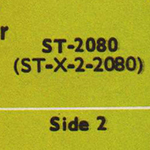 |
Catalog No. "ST-2080" was
printed at the right side of the center hole. |
||||||||||||||||||||||||||||||||
| LABEL CLOSE UP | |||||||||||||||||||||||||||||||||||
| SIDE 1 --> Click! |
SIDE 2 --> Click! |
The
song titles, songwriters credits, BMI and running
times below the center hole. Do not have running times for either "Long Tall Sally" or "I Call Your Name" |
|||||||||||||||||||||||||||||||||
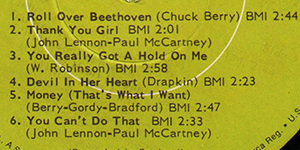 |
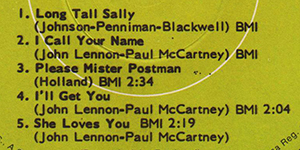 |
||||||||||||||||||||||||||||||||||
| LABEL CLOSE UP | |||||||||||||||||||||||||||||||||||
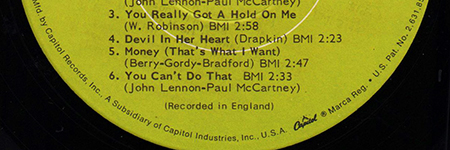 |
The text of the perimeter print in black on the original issue discs states "Mfd. by Capitol Records. Inc. A Subsidialy of Capitol Industries, Inc. U.S.A." to the left of a small Capitol logo, with "• Marca Reg. • U.S. Pat. No. 2, 631,859" to the right. | ||||||||||||||||||||||||||||||||||
|
OTHER ITEM
|
|||||||||||||||||||||||||||||||||||
| - | |||||||||||||||||||||||||||||||||||
| LABEL | Capitol
Lime Green Target label with TM mark |
||||||||||||||||||||||||||||||||||
| MIX | STEREO |
||||||||||||||||||||||||||||||||||
| VINYL COLOR | Black |
||||||||||||||||||||||||||||||||||
| PRESS FACTORY |
SLEEVE | Winchester,
Virginia |
|||||||||||||||||||||||||||||||||
| VINYL | Winchester
Press |
||||||||||||||||||||||||||||||||||
| FACTORY CODE | 12 |
||||||||||||||||||||||||||||||||||
| MATRIX No. | SIDE 1 |
ST-1-2080-N6
◁
(hand etched) |
|||||||||||||||||||||||||||||||||
| SIDE 2 |
ST-2-2080-W8 ◁ (hand etched) | ||||||||||||||||||||||||||||||||||
| PUBLISHER'S NAME |
- |
||||||||||||||||||||||||||||||||||
|
"SUBSIDIARY" PRINT
|
YES |
||||||||||||||||||||||||||||||||||
| COVER FORM |
Single
type.
Housed
in a cardboard jacket. |
||||||||||||||||||||||||||||||||||
| INNER SLEEVE | Capitol
Company
Sleeve
Type-6: Orange sleeve (Sound Great!) |
||||||||||||||||||||||||||||||||||
| COVER DESIGN/ PHOTO/ NOTES | Front
Cover
Design:
George Osaki All Photos: Joe Covello / Black Star |
||||||||||||||||||||||||||||||||||
| PRODUCER | Produced
in
London
by George Martin |
||||||||||||||||||||||||||||||||||
|
COMMENTS
|
The Beatles' Second Album is the
Beatles' second Capitol Records album, and their third album
released in the United States including Introducing... The
Beatles released three months earlier on Vee-Jay Records.
The Beatles' Second Album replaced Meet the Beatles! at
number one on the album charts in the US. The white front cover to "The Beatles' Second Album" , which was also designed by George Osaki, features a layout of sepia-tinted photographs of the band. There are two group shots: one posing in front of a curtain at The Ed Sullivan Show and one from the Kennedy airport press conference. All photos were taken by Joe Covello and licensed through Black Star. The initial slicks have the group's name in a brownish red and the song titles in dark green. Later slicks have "THE BEATLES" in bright red and the song titles in olive green. The black and white back liner also features photographs of the band. Four of the pictures feature Ed Sullivan Show performances. Three is also a performance shot from the Washington Coliseum concert. In July 1969, Capitol switched to a limecolored label featuring its new circle logo at the top. The outer "C" is purple and the circle representing the record is black. The initial lime labels have a TM designation following the word Capitol. After the trade mark for the logo was secured, the TM marking was switched to the (R) symbol, which appears below the "I" in Capitol. The lime-background circle logo label was used for Capitol Beatles albums until late spring, 1971. At about the time when the green label was discontinued, (May, 1971), the Beatles catalog was switched onto the Apple label. In May, 1971, Capitol redesigned their mainline label to use a more striking red background. The purple gCh logo remained at the top of the label. The registered trademark symbol appears to the right of the word "Capitol." This label appeared on Capitol records numbered from about 682 (May 1971) to about 838 (October 1971). Since the Beatles' catalog switched to Apple that same month, only a few rare specimens survive with this label style: some copies of Revolver and at least two copies of Yesterday...And Today. The following tables detail the cover numbers that are known to exist: Compiled by Frank Daniels in 2012 The Beatles' Second Album (S)T-2080
|
||||||||||||||||||||||||||||||||||
